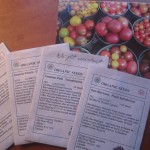Seeds Explained
Whether you’re a seasoned vegetable gardener or just starting out, the task of choosing seeds is a necessary chore. I don’t mean for it to sound negative, it’s just something that has to be done if you want to be picking fresh carrots and lettuce from the garden this year.
Let’s talk seeds first. The terms used on seed packages can be foreign to those who don’t garden regularly, or, more specifically, don’t grow vegetables regularly. A little clarification now will go a long way.
Definitions
Heirloom: Typically one thinks of heirloom as varieties that have been passed down for generations but there is more to it. Heirloom seeds are often open-pollinated (we’ll get to that in a minute), they are grown using natural selection rather than hybridization. When you hear about ‘seed savers’, they are usually saving these heirloom seeds.
Hybrid: Hybrid seeds are produced by combining two plants with exceptional traits with the hope that the resulting plant will have those traits. Seeds from a hybridized plant will not likely grow to display those sought-after qualities.
Organic: If a seed is labeled as certified organic, it has been grown in conditions where only organic chemicals have been applied. Please note that organic does not mean chemical-free. Organic seeds are GMO/GE free.
Open Pollinated: Open pollinated plants are pollinated using natural methods, the seeds will grow true to their parent plant. Hybrid plants are the opposite to open pollinated ones.
GMO/GE: GMO = Genetically Modified Organism; GE = Genetically Engineered. There are slight differences, however. Genetic engineering is when a plant is subjected to unnatural processes (this can be the insertion of a gene to improve insect resistance, for example). These seeds are highly controlled by manufacturers. Genetic modification includes genetic engineering but it also includes hybridization where plant breeders are selecting for specific beneficial traits.
Treated: Seeds labeled as ‘treated’ have undergone some sort of chemical treatment: a fungicide or insecticide.
Buying Seeds
Now that we’re all up to speed, let’s talk seed buying. If this is your first time buying seeds, let me warn you: you will be overwhelmed. There is an unbelievable amount of variety these days and you have to have a good handle on those definitions above if you want to choose the right seeds for you.
Know what you’re looking for before you step foot in the store. This will keep you focused. Take these definitions with you if you’re not sure you’ll be able to keep them straight.
I prefer to use Organic or Heirloom seeds. I find they taste so much better even if they are a bit more difficult to keep free of pests and diseases.
Online Catalogues
Thanks to the technological age we live in, what was once only available in a multi-paged flyer (or short novel in some cases), is now available online. McKenzie Seeds is a great place to start and you can use their website to find a store near you that carries what you’re looking for.
I also like to support local folks which is why I frequent the farmers’ markets and organic food conferences: there are always seed sellers available to help you. I picked up tomato and carrot seeds while at the Guelph Organic Conference earlier this month. Couldn’t be happier.

Space Planning
This is a big topic and I will cover it properly in another blog you can be sure. For now though, consider reading last week’s blog to start. You’ll then want to do your seed research (websites like McKenzie provide a good deal of information on their seeds) and determine how much space that type of vegetable will need. Your planning begins here and we will pick it up again as it gets closer to planting time!



